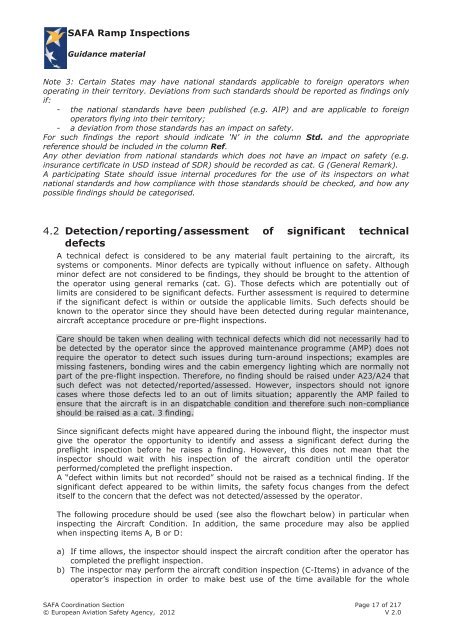SAFA Ramp Inspections - Code7700
SAFA Ramp Inspections - Code7700
SAFA Ramp Inspections - Code7700
Create successful ePaper yourself
Turn your PDF publications into a flip-book with our unique Google optimized e-Paper software.
<strong>SAFA</strong> <strong>Ramp</strong> <strong>Inspections</strong>Guidance materialNote 3: Certain States may have national standards applicable to foreign operators whenoperating in their territory. Deviations from such standards should be reported as findings onlyif:- the national standards have been published (e.g. AIP) and are applicable to foreignoperators flying into their territory;- a deviation from those standards has an impact on safety.For such findings the report should indicate ‘N’ in the column Std. and the appropriatereference should be included in the column Ref.Any other deviation from national standards which does not have an impact on safety (e.g.insurance certificate in USD instead of SDR) should be recorded as cat. G (General Remark).A participating State should issue internal procedures for the use of its inspectors on whatnational standards and how compliance with those standards should be checked, and how anypossible findings should be categorised.4.2 Detection/reporting/assessment of significant technicaldefectsA technical defect is considered to be any material fault pertaining to the aircraft, itssystems or components. Minor defects are typically without influence on safety. Althoughminor defect are not considered to be findings, they should be brought to the attention ofthe operator using general remarks (cat. G). Those defects which are potentially out oflimits are considered to be significant defects. Further assessment is required to determineif the significant defect is within or outside the applicable limits. Such defects should beknown to the operator since they should have been detected during regular maintenance,aircraft acceptance procedure or pre-flight inspections.Care should be taken when dealing with technical defects which did not necessarily had tobe detected by the operator since the approved maintenance programme (AMP) does notrequire the operator to detect such issues during turn-around inspections; examples aremissing fasteners, bonding wires and the cabin emergency lighting which are normally notpart of the pre-flight inspection. Therefore, no finding should be raised under A23/A24 thatsuch defect was not detected/reported/assessed. However, inspectors should not ignorecases where those defects led to an out of limits situation; apparently the AMP failed toensure that the aircraft is in an dispatchable condition and therefore such non-complianceshould be raised as a cat. 3 finding.Since significant defects might have appeared during the inbound flight, the inspector mustgive the operator the opportunity to identify and assess a significant defect during thepreflight inspection before he raises a finding. However, this does not mean that theinspector should wait with his inspection of the aircraft condition until the operatorperformed/completed the preflight inspection.A “defect within limits but not recorded” should not be raised as a technical finding. If thesignificant defect appeared to be within limits, the safety focus changes from the defectitself to the concern that the defect was not detected/assessed by the operator.The following procedure should be used (see also the flowchart below) in particular wheninspecting the Aircraft Condition. In addition, the same procedure may also be appliedwhen inspecting items A, B or D:a) If time allows, the inspector should inspect the aircraft condition after the operator hascompleted the preflight inspection.b) The inspector may perform the aircraft condition inspection (C-Items) in advance of theoperator’s inspection in order to make best use of the time available for the whole<strong>SAFA</strong> Coordination Section Page 17 of 217© European Aviation Safety Agency, 2012 V 2.0
















